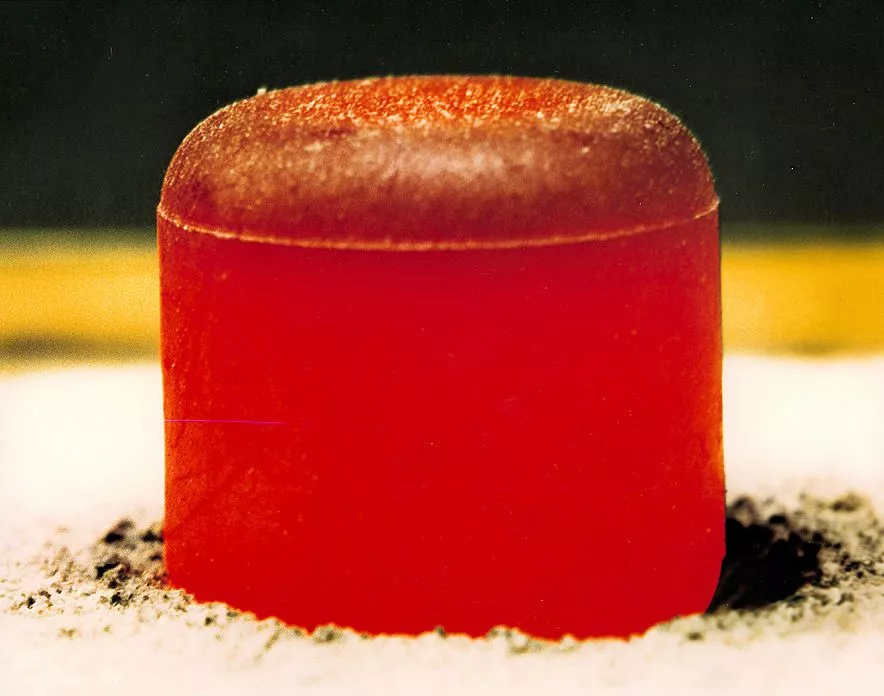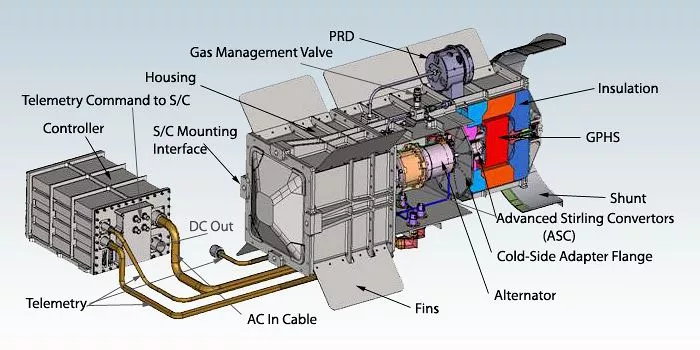NASA has announced the cancellation of the decade-old program to develop a Sterling Radioisotope Generator for deep-space missions. This program was a response to the critical shortage in radioactive isotopes in general, and plutonium-238 in particular, in the US and worldwide. NASA will now be depending on rebuilding a Pu-238 production system, an option that is not without its drawbacks and challenges.
Radioisotope thermoelectric generators work by converting the heat generated by a radioactive isotope to electricity using an array of thermocouples. In particular, Pu-238 fuel, which generates about half a kilowatt of heat per kilogram of isotope, has been used to power space missions and remote military installations since the early 1960s. RTGs have been carried to the Moon, and power most deep-space probes from Voyager through New Horizons, as well as the Curiosity Mars Rover.

The problem is that no one on Earth has made Pu-238 for RTGs for a couple of decades, and the supply has just about run dry.
Why should we care? According to one NASA official, if NASA doesn't find a new source of Pu-238 for its RTGs by 2022, "then we won't go beyond Mars anymore. We won't be exploring the solar system beyond Mars and the asteroid belt." Without Pu-238, a decades-long hiatus in deep-space space missions is to be expected.
Pu-238 has nearly ideal properties for powering space missions whose duration is years to a few decades. It is, unfortunately, quite difficult to produce in pure form (artificial isotopes are like that). The historic cost of Pu-238 has never been clear, as production for civilian uses was largely a side effect of weapons production and military satellite uses.
In 1992, the US arranged to buy 30 kg of Pu-238 from Russia for US$6M ($200K/kg). Even counting the effects of inflation, this was a real bargain, although in the end only about 20 kg was delivered.
Cost estimates for Pu-238 production following a $150M restart cost were $6M per kg this year, an estimate probably several times too low when considering that a $20-30M yearly program is expected to produce only 1-2 kg/yr.
If the price does settle into the range of $10-15M/kg, then the cost of fuel for a typical deep-space probe (about 8 kg or 18 lb) would be in the neighborhood of $100M, significantly increasing mission cost, and with it, mission viability.

NASA's Planetary Science Division (PSD) has been investing in development of a radioisotope-fueled Sterling engine generator (SRG) to take over the role of RTGs for future deep-space probes. While the particular program that was just cancelled began in 2009, the overall program has been active for more than a decade.
The reason to develop Sterling radioisotope generators is that an RTG only converts about 6 percent of the heat energy from decay of the radioisotope into electricity. The 8 kg of Pu-238 that powers the latest generation of deep-space probes generates about 4.4 kw of decay heat, but only 300 watts of electric power.
Instead, the combination of a Stirling engine that is powered by decay heat and an efficient electric generator offers an overall conversion efficiency into electric power of about 25 percent, meaning that an SRG could supply the 300 watts of electricity to a deep-space probe using only about 2 kg of Pu-238, representing a savings of roughly $75M, but also the ability to launch more missions. With current RTG designs, the deep-space program will be facing very long intervals waiting for Pu-238 supplies between launches.
Instead, we will stick with fuel-inefficient RTGs and a very limited Pu-238 source. Moreover, while the NASA PSD is now expected to pay the Department of Energy for both the Pu-238 restart and production costs, the DOE budget for this program has not been transferred to PSD, as is usually done in such cases. NASA is receiving about $10M per year at present to carry out a $150M restart project in the next seven years.
It appears to this occasionally paranoid writer that the only purpose of this plan, if indeed it was conceived with a purpose in mind, is to largely shut down NASA's Planetary Science Division by preventing it from carrying out a sustainable launch program. It does seem clear that, intended or not, this is likely to be the effect.
Source: Lunar and Planetary Institute







